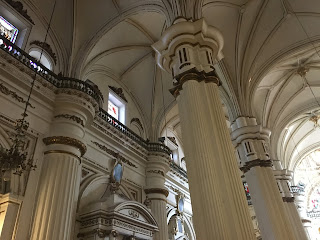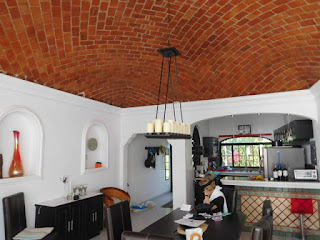We took our first excursion today through at group called Charter Club, which turns out to be run by a group of ex-pat Canadians. We were a group of ten, and all of the others were Canadian. We were all sympatico on this one-day trip to Guadalajara and Tlaquepaque.
The day had some stress since we’ve been having trouble with our door locks (the second day we actually had to call the person in charge to come and open the door). Well, that potential crisis passed. Then I couldn’t figure out the taxi transportation quickly enough, so we had to walk the 1.4 miles to Black Coffee, our meeting point across from WalMart. We trekked along rather quickly, and arrived within 30 minutes. We met several ex-pat walkers along the way, and the walk turned out to be quite pleasant.
So we boarded our bus and off we went. Rosie, our guide and our driver, was a wealth of information. The major portion of our tour was spent in downtown Guadalajara, and this posting will focus on our tour there. Another posting will focus on the mural art of Orozco and a third on our lunch and shopping in the artisan town of Tlaquepaque.
First, the tour of the historic Center of Guadalajara. Our tour focused on our trek around the area that was designed in the shape of the cross. You can’t tell that when you’re walking it, of course, but from above you can see the cross shape. In the center of the cross is the Guadalajara Cathedral, and the three top shorter sides all have park areas with fountains, statues, and various governmental buildings. The longer bottom section of the cross includes more parks and the foot of the cross is the old and majestic opera building. The back side of the opera building is a commemorative sculpture of the founding of Guadalajara in 1542.

First, the Guadalajara Cathedral, also called the Cathedral of the Assumption of Our Lady, is located in the center. It has gone through many incarnations. The first part of the present-day church was built in 1542. Its many incarnations have been and still are being damaged by earthquakes, and currently, there is a slight tilt to the north tower and damage to the dome. That said, it is a beautiful cathedral with gold leaf, silver, columns, stained glass windows, a German pipe organ — it’s all there. Here are some pictures to give you a sense of the place.
Then, as mentioned before, the heart of the cross — the cathedral — is surrounded by several squares, each one specific in intent (like honouring heroes, etc.). Here are some pictures of those areas.
 |
| Miguel Hildago is breaking chains from the Church and the elite. |
 |
| As we approached the left part of the cross, we see the cupola in this area. |
 |
| In the early times the women would go out every morning to cover the breasts of these female muses, all done in bronze. Every evening workers would take off the “clothes.” They painted the statues green, and thus they weren’t so lewd, and the covering stopped. ?? |

 |
| We observed horse-led carriages - but this is the "horse-less" that we saw. |
The opera house was beautiful.
 |
| The workman was cleaning up the statuary behind the opera house which signifies the birth of the nation in 1542. |
Rose, our guide, talked about three things that are unfortunate in this large public area. First, the area will never become a UNESCO Heritage Site because they have either torn down buildings and rebuilt them (in the style of ancient times, but not as replicas) or else they have covered the facades to make them look more modern. She was very disappointed that the city was not paying more attention to the older buildings. We are too.
Secondly, the effects of earthquakes can see seen. During one of the earthquakes, a steeple on the cathedral fell, and they have had to be replaced. The effects of earthquakes were visible when pointed out to us.
Thirdly, they have built an underground subway system under this entire area, and the area beneath the buildings is sinking :-(. Thus, the buildings are sinking and tilting in some cases. You could see several areas where they were trying to shore up the constructions. Scary.
 |
| Here, the arches are being supported. |
 |
| Note the wooden supports on the columns supporting the arches and the steeple. |
The entire “historical” section of the city was beautiful, and it was delightful to see all the groups of school kids (all very well behaved), the workers, the tourists, and other visitors enjoying the areas.

































































